🌏 Discover Australia’s Top 9 Must-Visit Destinations for Vacations 🇦🇺
Explore the Best Places to Visit in Australia

Australia, the land down under, is a vast and diverse country that offers an incredible range of experiences for travelers. From stunning natural landscapes to vibrant cities, Australia has something for everyone. Whether you’re an adventure seeker, a nature lover, a history buff, or simply looking to relax on pristine beaches, this country has it all.
In this blog post, we’ll take you on a journey through the top 9 best places to visit in Australia. So, pack your bags and get ready to explore the beauty and wonders of this extraordinary destination.
1. Sydney, New South Wales
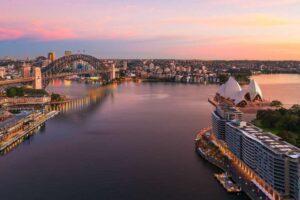
A. Sydney Opera House
The Sydney Opera House is an iconic masterpiece of modern architecture that graces the shores of Sydney Harbour. Designed by Danish architect Jørn Utzon and opened in 1973, it has become a symbol of both Sydney and Australia as a whole. This UNESCO World Heritage-listed site is renowned not only for its architectural brilliance but also for the world-class performing arts it hosts.
The unique design of the Sydney Opera House, with its distinctive sail-like shells, is a marvel to behold. These white, gleaming structures stand in stark contrast to the deep blue waters of the harbor, making it a photographer’s dream. Whether viewed from a distance or up close, the Opera House never fails to leave a lasting impression.
Inside, the Opera House boasts multiple performance venues, including the Concert Hall and the Joan Sutherland Theatre, which host a wide range of events, from symphony orchestras and ballets to contemporary music concerts and theater productions. Visitors can enjoy guided tours that provide insights into the history and architecture of this cultural icon.
When in Sydney, attending a performance or simply exploring the Opera House and its surroundings is a must. It’s not just a venue for the arts but also a social and cultural hub where locals and tourists gather to admire the architecture, enjoy fine dining at waterfront restaurants, and soak up the vibrant atmosphere of this Australian treasure.
B. Sydney Harbour Bridge
The Sydney Harbour Bridge, affectionately known as the “Coathanger” due to its distinctive arch shape, is another iconic landmark that defines the city’s skyline. Opened in 1932, this steel through-arch bridge not only serves as a vital transportation link but also offers breathtaking views and a sense of adventure to those willing to climb its heights.
One of the best ways to experience the Sydney Harbour Bridge is by taking a leisurely walk or cycle across its pedestrian path. The path provides panoramic vistas of the Sydney Opera House, Circular Quay, and the harbor itself. For the more adventurous, the BridgeClimb experience allows you to ascend to the summit, 134 meters above sea level, offering unmatched 360-degree views of Sydney and its surroundings.
The bridge plays a crucial role in Sydney’s transportation network, connecting the Central Business District (CBD) with the North Shore. It carries road and rail traffic, making it an engineering marvel of its time. The bridge is also illuminated at night, creating a stunning visual display that adds to Sydney’s nighttime charm.
Visitors can learn about the bridge’s history and construction at the Pylon Lookout and Museum, located in the southeastern pylon. This museum provides fascinating insights into the challenges faced during its construction and the impact it has had on the city.
C. Bondi Beach
Bondi Beach is Sydney’s most famous stretch of coastline, attracting both locals and international visitors year-round. Located just a short drive from the city center, Bondi is renowned for its golden sands, turquoise waters, and vibrant beach culture.
Surfers flock to Bondi for its consistent waves, making it a popular spot for those looking to catch some waves or learn to surf. The Bondi Surf Bathers’ Life Saving Club, one of the world’s oldest surf life-saving clubs, watches over swimmers and surfers alike, ensuring a safe experience for all beachgoers.
Apart from water activities, Bondi offers a range of dining options, from casual cafes to upscale restaurants. The Bondi Icebergs Club, perched on the southern end of the beach, not only provides great dining but also a stunning ocean pool that seems to merge with the Pacific Ocean.
The Bondi to Coogee Coastal Walk is a must-do activity for those looking to explore the breathtaking coastline on foot. This scenic coastal trail winds its way along cliffs, past secluded coves, and offers breathtaking views of the ocean. It’s a perfect way to immerse yourself in the natural beauty of Sydney.
Bondi Beach also hosts numerous events throughout the year, including the famous Sculpture by the Sea exhibition, which transforms the coastline into an open-air art gallery. Whether you’re looking to relax on the sand, take a dip in the ocean, or explore the vibrant culture surrounding the beach, Bondi has something for everyone.
Related Post: Vacations in Cuba
2. Great Barrier Reef, Queensland
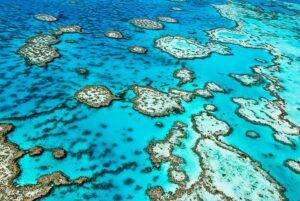
A. Snorkeling and Diving
The Great Barrier Reef, located off the coast of Queensland, is a natural wonder of unparalleled beauty and biodiversity. It’s the largest coral reef system on the planet and a UNESCO World Heritage Site. One of the best ways to explore this underwater paradise is through snorkeling and diving.
Snorkeling allows you to get up close and personal with the vibrant marine life and colorful coral formations that inhabit the reef’s crystal-clear waters. With a mask, snorkel, and fins, you can effortlessly glide over the coral gardens, observing the myriad of fish, turtles, and other aquatic creatures that call this reef home.
For those seeking a more immersive experience, scuba diving is a must. The Great Barrier Reef offers a diverse range of dive sites, suitable for both beginners and experienced divers. Whether you’re exploring the outer reef’s dramatic drop-offs or the inner reef’s shallow lagoons, there’s a dive site to suit your skill level and interests.
One of the most famous dive spots on the Great Barrier Reef is the Cod Hole, known for its encounters with large and friendly potato cod. Another highlight is the Ribbon Reefs, where you can witness incredible coral formations and marine life.
To ensure the preservation of this delicate ecosystem, it’s important to choose eco-friendly operators who prioritize sustainable tourism practices. Many tour companies offer guided snorkeling and diving experiences, providing expert knowledge about the reef’s ecology while minimizing environmental impact.
The Great Barrier Reef is a place of wonder and amazement for both novice snorkelers and seasoned divers. It’s an experience that will leave you with memories of a lifetime, where you can witness the beauty of the world beneath the waves.
B. Whitsunday Islands
The Whitsunday Islands, nestled within the heart of the Great Barrier Reef, are a tropical paradise known for their stunning beaches, lush rainforests, and crystal-clear waters. Comprising 74 islands, these pristine gems offer a range of activities and attractions, making them a dream destination for travelers seeking relaxation, adventure, and natural beauty.
Whitehaven Beach, consistently ranked as one of the world’s most beautiful beaches, is a crown jewel of the Whitsundays. Its pure silica sand stretches for 7 kilometers, creating a mesmerizing contrast with the azure waters. Visitors can take scenic boat trips to Whitehaven Beach, where they can swim, sunbathe, and explore the scenic Hill Inlet lookout for panoramic views of the beach’s swirling sandbars.
Sailing is a popular way to explore the Whitsundays, with numerous charter companies offering day trips and overnight excursions. Whether you’re an experienced sailor or a novice, you can experience the thrill of cruising through the pristine waters, anchoring in secluded coves, and snorkeling among vibrant coral gardens.
The Whitsundays are also home to diverse marine life, including turtles, dolphins, and a variety of fish species. Snorkeling and diving enthusiasts can explore the fringing reefs surrounding the islands, encountering colorful corals and an array of underwater creatures.
In addition to water-based activities, the Whitsundays offer opportunities for bushwalking and rainforest exploration. On the largest island, Whitsunday Island, visitors can hike to the famous Hill Inlet lookout or follow trails that lead through lush forests.
For a luxurious escape, the Whitsundays boast several upscale resorts and private island retreats, ensuring a serene and indulgent experience in this tropical paradise. Whether you’re seeking adventure, relaxation, or a bit of both, the Whitsunday Islands offer an idyllic getaway within the Great Barrier Reef region.
3. Uluru-Kata Tjuta National Park, Northern Territory
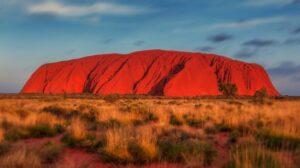
A. Uluru (Ayers Rock)
Uluru, also known as Ayers Rock, is one of Australia’s most iconic natural landmarks, situated within the awe-inspiring Uluru-Kata Tjuta National Park in the Northern Territory. This colossal sandstone monolith rises majestically from the red desert landscape, drawing visitors from around the world to witness its sheer grandeur and cultural significance.
Uluru is not merely a geological wonder; it holds deep cultural and spiritual importance to the Anangu people, the traditional owners of the land. As such, it is essential to approach this sacred site with respect and reverence. Visitors can gain valuable insights into the rich indigenous culture and history through guided tours led by Anangu guides, who share their ancestral stories and traditions.
One of the most mesmerizing aspects of Uluru is its ability to change colors as the sun traverses the sky. Sunrise and sunset are prime times to witness this phenomenon when the rock transforms from deep red to vibrant orange and various shades in between. Photographers and nature enthusiasts alike flock to designated viewing areas to capture the breathtaking moments as the light plays on the rock’s surface.
The Mala Walk and the Base Walk are popular walking trails that allow you to explore Uluru up close. Along these paths, you can observe ancient rock art, waterholes, and unique geological formations. The Mutitjulu Waterhole, a tranquil oasis at the base of Uluru, holds cultural significance and is a place of serenity and reflection.
In addition to cultural experiences and nature walks, Uluru offers a range of accommodation options, from luxury resorts to campgrounds, allowing visitors to immerse themselves in the natural surroundings and experience the magic of the desert night sky.
B. Kata Tjuta (The Olgas)
Kata Tjuta, also known as The Olgas, is a remarkable natural formation located just a short drive from Uluru within the Uluru-Kata Tjuta National Park. While Uluru tends to steal the spotlight, Kata Tjuta is equally captivating and holds its own unique allure.
Kata Tjuta consists of a group of large, domed rock formations that rise dramatically from the desert floor. The name “Kata Tjuta” means “many heads” in the local Anangu language, a fitting description for this cluster of colossal rock formations.
Exploring Kata Tjuta is an adventure in itself. The Valley of the Winds Walk is a popular trek that allows you to venture between the towering rock domes. Along the way, you’ll encounter breathtaking vistas of the surrounding landscape and learn about the cultural significance of Kata Tjuta through interpretive signs.
Sunset at Kata Tjuta is a magical experience, just as it is at Uluru. The changing colors of the rock formations against the setting sun create a captivating and surreal atmosphere. Visitors can watch this natural spectacle from designated viewing areas while enjoying the tranquility of the desert.
Kata Tjuta also holds cultural importance to the Anangu people, and it’s essential to approach the site with respect and consideration for its spiritual significance. Guided tours offer valuable insights into the cultural heritage of this extraordinary place.
For those looking to fully immerse themselves in the wonders of the Australian Outback, the Uluru-Kata Tjuta National Park provides camping facilities, allowing visitors to spend a night under the star-filled desert sky, connecting with nature in a profound way.
4. Melbourne, Victoria
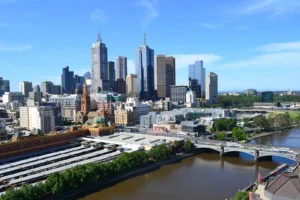
A. Federation Square
Federation Square, often referred to as “Fed Square,” is a cultural and architectural masterpiece nestled in the heart of Melbourne’s Central Business District (CBD). It serves as a vibrant hub for arts, culture, and community gatherings, making it an essential stop for both locals and visitors.
This modern and visually striking square features a diverse range of attractions. The Australian Centre for the Moving Image (ACMI) is a prominent cultural institution located within Fed Square, showcasing the art of film, television, and digital media. It offers immersive exhibitions and screenings that provide an engaging experience for film enthusiasts of all ages.
Fed Square is also home to numerous galleries, restaurants, cafes, and bars, making it a food and beverage haven for those seeking culinary delights. Its open-air spaces host various events and festivals throughout the year, from outdoor cinemas to live music performances, ensuring there’s always something exciting happening.
The architectural design of Fed Square is a captivating blend of modernity and innovation. The juxtaposition of angular lines and striking facades against the backdrop of Melbourne’s historic Flinders Street Station creates a unique visual appeal that draws photographers and architecture enthusiasts alike.
Visitors can enjoy panoramic views of the city from the square’s elevated terraces, making it an ideal spot for photography and relaxation. Fed Square is also conveniently located near other Melbourne landmarks such as Flinders Street Station, St. Paul’s Cathedral, and the Yarra River, making it an easily accessible starting point for exploring the city.
B. Melbourne Cricket Ground (MCG)
The Melbourne Cricket Ground, affectionately known as the “G,” is an iconic sports stadium and cultural institution that holds a special place in the hearts of Melburnians. It’s the largest stadium in the Southern Hemisphere and a revered venue for cricket, Australian rules football, and major events.
Cricket enthusiasts from around the world pilgrimage to the MCG, particularly during the summer months when it hosts international cricket matches. The Ashes, One-Day Internationals, and the Boxing Day Test match are just a few of the marquee events that grace its hallowed turf.
For Australian rules football fans, the MCG is the ultimate destination. It’s the home ground for the Melbourne Cricket Club and hosts numerous AFL matches throughout the season, culminating in the prestigious AFL Grand Final, one of the most-watched sporting events in Australia.
Beyond sports, the MCG is a place of historical significance and offers immersive experiences for visitors. The National Sports Museum, located within the stadium, showcases Australia’s sporting heritage through interactive exhibits and memorabilia. Visitors can also take guided tours that provide behind-the-scenes access to the stadium, including the player’s change rooms and the iconic Long Room.
C. Great Ocean Road
The Great Ocean Road is a world-renowned coastal drive that stretches along the southern coast of Victoria. This scenic route is a meandering journey that takes you through some of Australia’s most breathtaking landscapes, making it a must-visit destination for nature enthusiasts and road-trippers.
One of the highlights of the Great Ocean Road is the Twelve Apostles, a collection of limestone stacks rising dramatically from the Southern Ocean. These natural wonders are particularly mesmerizing at sunrise and sunset when the changing light creates stunning photographic opportunities.
The road also winds its way through lush rainforests, charming seaside towns, and pristine beaches. Visitors can explore the Great Otway National Park, where walking trails lead to secluded waterfalls and offer the chance to spot native wildlife, including koalas and colorful bird species.
For those seeking adventure, the Great Ocean Road is a surfer’s paradise, with numerous surf breaks along the coast. Alternatively, you can opt for a scenic helicopter flight to gain a bird’s-eye view of the rugged coastline and the azure waters of the Southern Ocean.
The Great Ocean Road’s coastal villages offer a warm and welcoming atmosphere, with a variety of accommodation options, dining experiences, and boutique shops. Towns like Apollo Bay and Lorne are perfect places to stop and savor the coastal lifestyle.
Whether you’re embarking on a day trip from Melbourne or a more extended road trip adventure, the Great Ocean Road promises a journey filled with natural beauty, outdoor activities, and a deep connection to Australia’s coastal heritage.
5. The Whitsunday Islands, Queensland
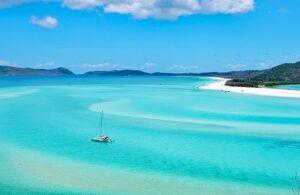
A. Whitehaven Beach
Whitehaven Beach is a pristine, postcard-perfect paradise located in the heart of the Whitsunday Islands, Queensland, Australia. This exquisite stretch of coastline is renowned worldwide for its powdery white silica sand, crystal-clear turquoise waters, and untouched natural beauty. It’s not just a beach; it’s a destination that defines tropical island perfection.
The soft, pure silica sand of Whitehaven Beach is unlike any other. It doesn’t retain heat, making it cool to the touch even on the hottest of days. As you walk along the shore, you’ll feel the sand’s gentle caress on your feet, making it an incredibly inviting and comfortable beach to explore.
The beach stretches for 7 kilometers, offering ample space for relaxation and beachcombing. The pristine waters are ideal for swimming, and snorkeling enthusiasts can discover a vibrant underwater world teeming with marine life. Rays, colorful fish, and even the occasional sea turtle can be spotted in the surrounding waters.
One of the most iconic features of Whitehaven Beach is the mesmerizing Hill Inlet. As the tide shifts, the swirling mix of blue and white hues creates a captivating, ever-changing mosaic of colors. It’s a sight that leaves visitors in awe and is best observed from the Hill Inlet lookout, a short hike from the beach.
Visiting Whitehaven Beach is often part of a larger Whitsunday Islands experience. Numerous boat tours and charters depart from the mainland and neighboring islands, offering day trips or overnight stays that allow visitors to immerse themselves in the natural beauty of this paradise. Camping is also available at selected spots for those who wish to experience the beach’s serenity overnight.
B. Hill Inlet
Hill Inlet is a natural marvel located near Whitehaven Beach in the Whitsunday Islands, Queensland. It’s a place of breathtaking beauty and is best known for its stunning, swirling patterns of blue and white that form as a result of the shifting tides.
Visitors to the Whitsundays often make their way to Hill Inlet to witness this natural phenomenon firsthand. To do so, they embark on a short hike from Whitehaven Beach to the Hill Inlet lookout, perched above the swirling waters below. The view from this vantage point is nothing short of spectacular, and it’s one of the most photographed spots in Australia.
The phenomenon at Hill Inlet is a result of the mix of fresh, clear water from the nearby creek and the surrounding seawater, creating a unique blend of colors and textures. As the tides change and the water moves, it creates an ever-shifting landscape that is both mesmerizing and ethereal.
Many visitors choose to explore Hill Inlet as part of a larger Whitsunday Islands adventure, often combining it with a visit to Whitehaven Beach. Guided tours, boat charters, and scenic flights offer various ways to experience Hill Inlet, each providing a different perspective of this natural wonder.
Hill Inlet is not just a visual marvel; it’s also a place of tranquility and natural beauty. The surrounding bushland and coastal environments provide opportunities for birdwatching, photography, and a deeper connection with the natural world.
6. The Great Ocean Road, Victoria
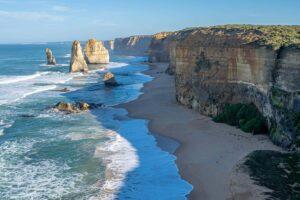
A. Twelve Apostles
The Twelve Apostles stand as one of the most iconic and dramatic natural wonders along the Great Ocean Road in Victoria, Australia. These colossal limestone stacks rise majestically from the Southern Ocean, offering a sight that has captivated travelers from around the world. Despite the name, there were never twelve stacks; the number has varied due to erosion, with fewer remaining today.
These towering rock formations have been sculpted over millions of years by the relentless forces of wind and waves. The result is a series of jagged sea stacks that stand sentinel along the rugged coastline. The orange-hued limestone contrasts brilliantly with the deep blue waters, creating a breathtaking visual spectacle that is particularly striking at sunrise and sunset.
Visitors flock to the Twelve Apostles for their natural beauty, but the surrounding landscape is equally captivating. The viewing platforms and walking trails that lead to various vantage points provide opportunities to take in the full scope of this stunning coastline. Photography enthusiasts will find endless inspiration here, as the changing light throughout the day adds new dimensions to the scene.
To fully appreciate the grandeur of the Twelve Apostles, it’s advisable to explore both sunrise and sunset, as the colors and shadows create a mesmerizing display. Guided tours and helicopter flights are available for those seeking a unique perspective from the air, allowing you to fully grasp the scale of these geological marvels.
While the Twelve Apostles are undoubtedly the highlight, the journey along the Great Ocean Road itself is an adventure filled with natural beauty. The road takes you through lush rainforests, charming coastal towns, and other iconic stops like Loch Ard Gorge, ensuring that the entire trip is a memorable experience.
B. Loch Ard Gorge
Loch Ard Gorge, located along the Great Ocean Road in Victoria, is a place of both beauty and tragedy. This stunning coastal formation is named after the ship “Loch Ard,” which ran aground nearby in 1878, leading to one of Australia’s most famous maritime survival stories.
The gorge is a spectacular geological wonder, with towering limestone cliffs framing a tranquil cove. The pristine beach at the bottom of the gorge offers a serene setting to relax and soak in the natural beauty. The clear waters are perfect for a refreshing swim, although caution is advised due to strong currents.
Visitors to Loch Ard Gorge can explore a series of walking trails and viewing platforms that provide panoramic vistas of the surrounding coastline. One such viewpoint is the Razorback, a rocky formation that extends into the ocean and offers breathtaking views of the Southern Ocean.
The story of the “Loch Ard” shipwreck and the dramatic rescue of two survivors, Tom Pearce and Eva Carmichael, adds a layer of historical significance to the area. The gorge’s visitor center features exhibits and displays that recount this compelling tale of tragedy and heroism.
In addition to its historical and geological attractions, Loch Ard Gorge is a prime location for birdwatching, as the surrounding cliffs provide nesting sites for various seabirds. It’s a place where visitors can connect with both nature and history, making it a worthwhile stop along the Great Ocean Road journey.
7. Kakadu National Park, Northern Territory
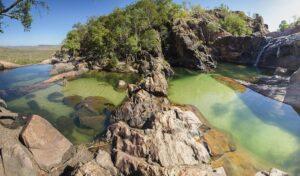
A. Aboriginal Rock Art
Kakadu National Park, situated in the Northern Territory of Australia, is a UNESCO World Heritage-listed treasure that boasts not only breathtaking landscapes but also one of the world’s most significant collections of Aboriginal rock art. These ancient artworks provide a glimpse into the rich cultural and historical heritage of the Indigenous people who have inhabited this region for thousands of years.
The rock art found within Kakadu National Park spans millennia, with some pieces dating back over 20,000 years. These intricate and mesmerizing creations are a testament to the enduring relationship between the Indigenous people and their land. The rock art sites serve as sacred places, storytelling canvases, and historical records.
One of the most renowned rock art sites within Kakadu is Ubirr, a sandstone outcrop that features a series of galleries adorned with striking rock paintings. Visitors can explore these galleries, guided by informative signage, to learn about the Dreamtime stories, cultural traditions, and the flora and fauna depicted in the art.
Nourlangie Rock, another significant site, is home to a wealth of rock art, including dynamic images of animals and human figures. Here, you can immerse yourself in the stories of the Anbangbang people, who have inhabited this area for generations.
Kakadu’s rock art sites are more than just drawings on stone; they are windows into a world that has endured for millennia. To explore these cultural treasures responsibly, visitors are encouraged to join guided tours led by knowledgeable Indigenous guides who offer profound insights into the significance and stories behind the art.
B. Yellow Water Billabong
Yellow Water Billabong, located within Kakadu National Park, is a haven of natural beauty and wildlife. This stunning wetland ecosystem is a prime example of the unique landscapes that make Kakadu a World Heritage Site. It is best experienced through boat cruises that take you through this thriving aquatic wonderland.
The billabong’s name is derived from the vibrant yellow water lilies that adorn its surface, creating a picturesque contrast with the green water and surrounding vegetation. Yellow Water is home to a diverse range of flora and fauna, making it a paradise for nature enthusiasts and birdwatchers.
During a cruise on Yellow Water Billabong, you can expect to encounter a rich array of wildlife, including crocodiles, water buffalos, and numerous bird species. The birdlife here is especially spectacular, with the billabong providing a habitat for hundreds of species, including the iconic jabiru, magpie geese, and agile wallabies along the banks.
Sunrise and sunset cruises are particularly popular, as the soft golden light bathes the billabong in a warm and enchanting glow. The reflective waters create stunning photographic opportunities, capturing the serene beauty of this unique wetland.
Kakadu’s Indigenous heritage is deeply intertwined with its natural wonders, and Yellow Water Billabong is no exception. Guided boat tours often feature knowledgeable Indigenous guides who share stories of the land, its cultural significance, and the traditional uses of the plants and animals that call this billabong home.
Visiting Yellow Water Billabong is a chance to connect with nature and gain a deeper understanding of the complex ecosystem that thrives within Kakadu National Park, making it an essential stop on any exploration of this unique wilderness area.
8. The Blue Mountains, New South Wales
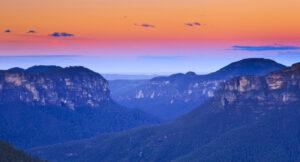
A. Three Sisters
The Three Sisters, located in the heart of the Blue Mountains in New South Wales, is an iconic rock formation that has captured the imaginations of visitors for generations. These three towering sandstone pillars, standing side by side, create a majestic panorama against the backdrop of the lush mountainous landscape.
According to Aboriginal legend, the Three Sisters represent three sisters from the Katoomba tribe who were turned into stone by a tribal elder to protect them from harm but unfortunately, he perished in battle, and no one could reverse the spell. The towering formations are not only a natural wonder but also hold cultural and spiritual significance for the local Indigenous people, the Gundungurra and Darug communities.
Visitors can experience the beauty of the Three Sisters from various viewpoints and lookout points along the Echo Point Lookout in Katoomba. The view is particularly breathtaking at sunrise and sunset when the changing light casts an enchanting glow over the rocky sentinels.
For those looking to get closer to the Three Sisters, a network of well-maintained hiking trails allows you to descend into the valley for a more intimate encounter. The Giant Stairway is a popular choice, offering a steep descent and spectacular views along the way.
To delve deeper into the legends and history surrounding the Three Sisters, the nearby Echoes Boutique Hotel and Restaurant features an Indigenous art gallery, providing insights into the cultural significance of this iconic landmark. Guided tours led by knowledgeable local guides also offer an opportunity to learn more about the area’s rich heritage.
B. Scenic World
Scenic World, nestled in the heart of the Blue Mountains, is an attraction that offers a unique perspective on this spectacular natural wonderland. It’s a place where visitors can experience the awe-inspiring beauty of the Blue Mountains from a range of thrilling vantage points and modes of transport.
One of the standout attractions at Scenic World is the Scenic Railway, known as the steepest passenger railway in the world. It descends into the lush Jamison Valley, providing a thrilling journey through ancient rainforests, complete with dramatic cliffs and waterfalls. The Scenic Railway is not only an adrenaline-pumping adventure but also an opportunity to explore the pristine wilderness of the Blue Mountains up close.
For those seeking a different perspective, the Scenic Skyway offers a cable car experience that glides high above the valley, providing breathtaking panoramic views. The glass floor provides a unique sensation of floating above the treetops and valleys below.
The Scenic Cableway is another option for those looking to explore the depths of the Blue Mountains. This cable car descends into the Jamison Valley, where you can explore the lush rainforest on elevated boardwalks.
Scenic World also offers the Scenic Walkway, which provides a tranquil stroll through the ancient rainforest, offering opportunities to learn about the unique flora and fauna that call this region home.
9. Tasmania
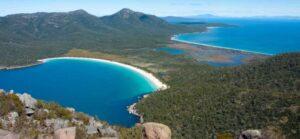
A. Hobart
Hobart, the capital city of Tasmania, is a charming and vibrant destination that offers a unique blend of history, culture, and natural beauty. Nestled on the shores of the Derwent River and surrounded by rolling hills, Hobart provides a picturesque setting that invites exploration and discovery.
One of Hobart’s standout attractions is the historic Salamanca Place. This waterfront precinct is renowned for its Georgian sandstone buildings, housing an array of galleries, boutiques, cafes, and restaurants. On Saturdays, Salamanca Market comes alive, offering a bustling marketplace where artisans and producers showcase their crafts and products.
For those interested in history, a visit to the Port Arthur Historic Site is a must. This former convict settlement provides a compelling insight into Australia’s colonial past. Guided tours and interpretive exhibits bring to life the stories of convicts, soldiers, and settlers who once called this place home.
Hobart’s vibrant arts and culture scene is showcased at the Museum of Old and New Art (MONA). This contemporary art museum is home to an eclectic collection of art and installations that challenge conventional boundaries. Accessible via a scenic ferry ride along the Derwent River, MONA is as much a journey as it is a destination.
Mount Wellington, towering above the city, offers panoramic views of Hobart and the surrounding region. Visitors can drive to the summit or embark on hiking trails that wind through alpine landscapes. Sunsets from Mount Wellington are particularly spectacular, casting a warm glow over the city.
The culinary scene in Hobart is thriving, with a focus on fresh, locally sourced ingredients. Visitors can savor Tasmania’s culinary delights in the city’s many restaurants and eateries, showcasing everything from artisanal cheeses and seafood to premium wines.
B. Freycinet National Park
Freycinet National Park, located on the east coast of Tasmania, is a natural wonderland that encompasses rugged coastal landscapes, pristine beaches, and stunning granite peaks. It’s a place where visitors can immerse themselves in the breathtaking beauty of Tasmania’s wilderness.
Wineglass Bay, with its crescent-shaped sandy beach and crystal-clear waters, is the park’s crown jewel. The view from the Wineglass Bay Lookout is one of the most photographed in Australia, offering a reward for those who hike to its summit. The hike to Wineglass Bay is just one of the many trails that wind through the park, allowing visitors to explore its diverse ecosystems.
Hazards Beach, accessible via walking trails or by kayak, offers a more secluded beach experience. The park is also a birdwatcher’s paradise, with a variety of bird species that inhabit its coastal heathlands and woodlands.
For those seeking adventure, Freycinet National Park offers kayaking, snorkeling, and rock climbing opportunities. Guided tours are available for those who wish to explore the park’s wonders with expert guidance.
Camping is available within the park, providing a unique opportunity to experience the wilderness under the starry night sky. Facilities are basic, allowing visitors to connect with nature in a serene and unspoiled environment.
Freycinet National Park is a place of tranquility and natural beauty, where visitors can escape the hustle and bustle of everyday life and reconnect with the pristine landscapes that make Tasmania a remarkable destination.
Frequently Asked Questions
Q. What is the best time to visit Australia?
A. The best time to visit Australia depends on your preferences. Generally, spring (September to November) and autumn (March to May) offer pleasant weather and fewer crowds.
Q. Do I need a visa to travel to Australia?
A. Yes, most travelers require a visa to enter Australia. Check the Australian government’s official website for visa requirements and application details.
Q. Are there dangerous animals in Australia?
A. Australia is known for its unique wildlife, including some potentially dangerous species. However, with proper precautions and awareness, encounters are rare.
Q. What are some popular Australian dishes to try?
A. Don’t miss out on trying classic Australian dishes like Vegemite, meat pies, Tim Tams, and seafood, including barramundi and prawns.
Q. Is it safe to swim in the ocean in Australia?
A. While Australia’s beaches are beautiful, some areas may have strong currents or marine life. Always heed warning signs and swim in designated areas.
Q. How can I explore the Outback safely?
A. Exploring the Australian Outback requires preparation. Ensure you have adequate supplies, water, and a reliable vehicle. It’s advisable to travel with a guide.
Conclusion
Australia’s diverse and breathtaking landscapes, along with its vibrant cities, make it an ideal destination for travelers seeking adventure, relaxation, and cultural enrichment. From the iconic Sydney Opera House to the natural wonder of the Great Barrier Reef, and from the awe-inspiring Uluru-Kata Tjuta National Park to the cosmopolitan city of Melbourne, Australia has something to offer every type of traveler.
Whether you’re exploring the rugged coastlines of the Great Ocean Road, delving into the rich Aboriginal history of Kakadu National Park, or discovering the pristine beauty of Tasmania, each destination on this list promises a unique and unforgettable experience. So, start planning your Australian adventure today, and let this list be your guide to the top 9 must-visit places in this incredible country.

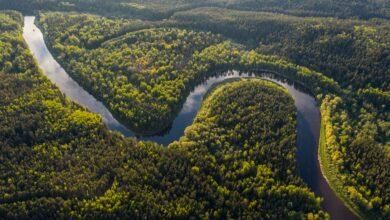


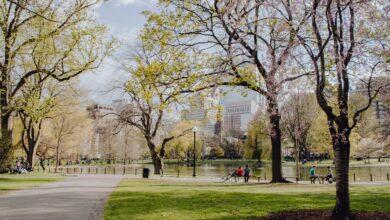
Facebook Comments